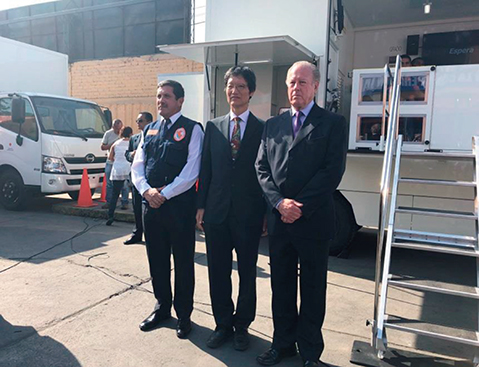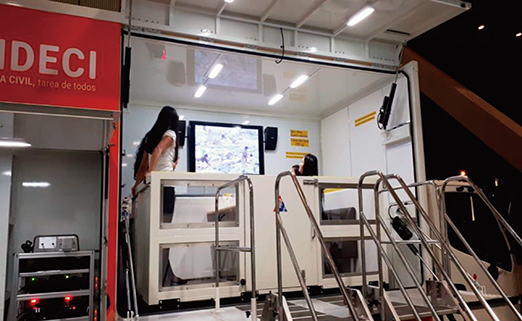Master Techniques from Japan to the World 1
Enhancing Disaster Prevention Awareness Among People with an Earthquake Simulation Vehicle
– Earthquake Simulation Vehicles to Peru where Earthquakes Happen Often
Since Peru is frequently hit by large earthquakes of magnitude 7 to 9 like Japan, we are deeply committed to strengthening disaster-prevention awareness among the population. In principle, the CESATT (el Centro de Sensibilización y Aprendizaje sobre Terremotos y Tsunamis) in UNI (Universidad Nacional de Ingeniería) in Peru carries out activities such as creating teaching materials and developing programs for disaster-prevention education, and providing enlightenment workshops and training. Various Japanese knowhow is being applied in these activities, through the cooperation of JICA including the dispatch of Japanese disaster-prevention experts.
As a part of this cooperation, based on Peru’s request for disaster-prevention related machinery and equipment, three Japanese Earthquake Simulation Vehicles were provided to Peru’s National Institute of Civil Defense (INDECI) in February 2018, under the ODA scheme called “Non-Project Grant Aid for Provision of Japanese SME’s Products.”* An Earthquake Simulation Vehicle has a vibration device attached to produce a simulated earthquake tremor, which allows people to have an experience of various types of earthquake by registering data of past earthquakes through analyses. These vehicles have actually been introduced in numerous localities in Japan. By experiencing real-life vibrations in the vehicle, residents are able to gain an awareness by themselves on how important preparing for earthquakes is, and measures to minimize damage are being implemented.

(From the right) Minister of Defense Kishik, Charge d’Affaires ad interim of Japan in Peru, Takagi, and Disaster Management Agency Director Chávez (Photo: Embassy of Japan in Peru)
The trigger for the introduction of the Earthquake Simulation Vehicles in Peru, was the visit by Mr. Jorge Chávez, Director of INDECI, to Japan, who experienced an earthquake on the Earthquake Simulation Vehicle. This led to his strong desire to raise awareness of disaster prevention among Peruvian children and pupils, by using Earthquake Simulation Vehicles with the latest Japanese technology, during disaster-prevention practice at educational institutes such as elementary and junior-high schools in Peru, and resulted in the provision of the Earthquake Simulation Vehicles. The manufacture of the vehicles sent to Peru was undertaken by Aska Motor Industry. Today, not only have Aska’s Earthquake Simulation Vehicles been introduced to every local government in Japan, including the 23 wards in Tokyo, but they have been sent to, and are active in foreign countries such as Algeria and Chile.
“Compared with Earthquake Simulation Vehicles from other countries, the cars that we make are characterized by the fact that they can turn in a small radius, which enables them to quickly get to various places, for a larger number of people to experience earthquakes, and furthermore, they are able to adjust to various types of ‘shaking,’” explains Mr. Kota Kawana, of the company’s Engineering Division. Aska’s Earthquake Simulation Vehicles allow us to experience simulated earthquakes up to magnitude 7 for two minutes at a time, and can be customized according to the needs, such as reproducing the shaking of past earthquakes (forward-back, left-right, and up-down directions), and freely setting the shaking. Mr. Kawana also went to Peru to give technical instruction on operation methods and maintenance to INDECI personnel. He says, “Even with the same earthquake, the damage situation in Peru can differ substantially from that in Japan, due to the different building structures between the countries. So, we have improved our Earthquake Simulation Vehicles so as to allow suitable disaster-prevention countermeasures in accordance with the local situation.”
The Japan-Peru Center for Earthquake Engineering and Disaster Mitigation (CISMID-UNI) began implementing disaster-prevention trainings of earthquake experiences, using these Earthquake Simulation Vehicles, from June 2018. To date, it has conducted enlightenment activities for 4,500 people at 22 disaster-prevention events. Most of the participants of these events said that the experience in the Earthquake Simulation Vehicle was extremely beneficial, and that it made them realize the importance of earthquake countermeasures. Although up until now earthquake experiences were provided through simple shaking devices owned by INDECI, the Earthquake Simulation Vehicles which can easily make small turns, are now visiting regions all over Peru so that the local people can experience the shaking of an earthquake. The Earthquake Simulation Vehicles are very useful in the disaster-prevention training of personnel engaged in disaster-prevention and citizens of Peru. Starting with the introduction of these Earthquake Simulation Vehicles, it is hoped that disaster-prevention awareness will further grow among the people of Peru going forward, and that preparations for large-scale disasters will be undertaken in every family.

A person in Peru experiencing an Earthquake Simulation Vehicle (Photo: INDECI)
* One of the former names of “Economic and Social Development Programs.” Grant Aid under the procurement agent system implemented by the Ministry of Foreign Affairs.
Next Page >>
Main Text | Reference Statistics | Stories from the Field | Master Techniques from Japan to the World | ODA Topics
